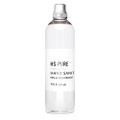 Loading... Please wait...
Loading... Please wait...Categories
Popular Brands
Our Newsletter
- Home
- CoVid-19
CoVid-19
Why choose 80% ethyl (ethanol) alcohol hand sanitizer?
Ethyl vs. Isopropyl
Even though Ethyl and Isopropyl Alcohol both kill bacteria, Ethyl alcohol at concentrations of 80%, is a much more potent virucidal agent inactivating fungus, all lipophilic viruses (e.g. herpes, vaccinia, and influenza virus) and many hydrophilic viruses (e.g. adenovirus, enterovirus, rhinovirus and rotaviruses). Isopropyl alcohol is excluded from classification as a high-level disinfectant because of its inability to eradicate bacterial spores and hydrophilic viruses such as polio or the Flu.
80% vs. Other Percentages
Higher or lower than 80% concentration both have disadvantages. The presence of water to dilute the Ethyl alcohol to exactly 80% is a crucial factor in destroying or inhibiting the growth of pathogenic microorganisms. Water acts as a catalyst and plays a key role in denaturing the proteins of vegetative cell membranes. 80% ethyl alcohol penetrates the cell wall more completely than lesser or higher percentages.
Ethanol concentrations over 91% coagulate proteins instantly. Consequently, a protective layer is created which protects other proteins from further coagulation which means that the microorganism can lay dormant then reactivate under the right conditions.
In testing of the effect of ethyl alcohol against M. tuberculosis, 80% ethanol killed the tubercle bacilli in sputum or water suspension within 15 seconds. When you compare that tuberculocidal activity of isopropanol (70%/volume) the contact times needed for complete destruction were 5 minutes.
How does 80% work?
80% ethanol permeates the entire cell, coagulates all proteins, and therefore the microorganism dies. 20% water content slows evaporation, therefore increasing surface contact time and enhancing effectiveness.
80% alcohol is ideal compared to stronger concentrations. Pure alcohol coagulates protein on contact. Suppose the pure alcohol is poured over a single-celled organism. The alcohol will go through the cell wall of the organism in all directions, coagulating the protein just inside the cell wall. The ring of the coagulated protein would then stop the alcohol from penetrating farther into the cell, and no more coagulation would take place. At this time, the cell would become inactive but not dead. Under favorable conditions, the cell would then begin to function. However, if 80% alcohol is poured onto a single-celled organism, the diluted alcohol also coagulates the protein, but at a slower rate, so that it penetrates all the way through the cell before coagulation can block it. Then the entire cell is coagulated and the organism dies.
In other words: The alcohol denatures the lipids in the cell wall - poking holes in the microorganism. The 20% water can then enter, and lyse (corrode), the cell.
New Products
-
$49.50

-
$54.95

-
$32.95

-
$49.95

-
$59.99






